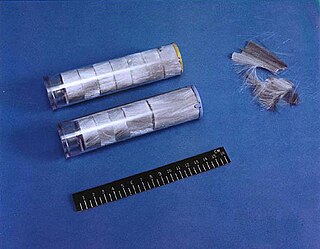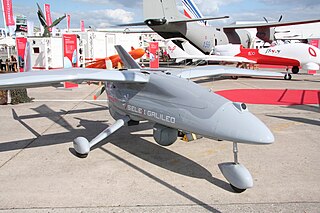
The Saab JAS 39 Gripen is a light single-engine supersonic multirole fighter aircraft manufactured by the Swedish aerospace and defence company Saab AB. The Gripen has a delta wing and canard configuration with relaxed stability design and fly-by-wire flight controls. Later aircraft are fully NATO interoperable. As of 2020, more than 271 Gripens of all models, A–F, have been delivered.

The Eurofighter Typhoon is a European multinational twin-engine, canard delta wing, multirole fighter. The Typhoon was designed originally as an air-superiority fighter and is manufactured by a consortium of Airbus, BAE Systems and Leonardo that conducts the majority of the project through a joint holding company, Eurofighter Jagdflugzeug GmbH. The NATO Eurofighter and Tornado Management Agency, representing the UK, Germany, Italy and Spain, manages the project and is the prime customer.

Leonardo S.p.A., formerly Leonardo-Finmeccanica and originally Finmeccanica, is an Italian multinational company specialising in aerospace, defence and security. Headquartered in Rome, Italy, the company has 180 sites worldwide. It is the 12th largest defence contractor in the world based on 2020 revenues. The company is partially owned by the Italian government, which holds 30.2% of the company's shares and is its largest shareholder.

The Euroradar Captor is a next-generation mechanical multi-mode pulse Doppler radar designed for the Eurofighter Typhoon. Development of Captor led to the Airborne Multirole Solid State Active Array Radar (AMSAR) project which eventually produced the CAESAR, now known as Captor-E.

An active electronically scanned array (AESA) is a type of phased array antenna, which is a computer-controlled antenna array in which the beam of radio waves can be electronically steered to point in different directions without moving the antenna. In the AESA, each antenna element is connected to a small solid-state transmit/receive module (TRM) under the control of a computer, which performs the functions of a transmitter and/or receiver for the antenna. This contrasts with a passive electronically scanned array (PESA), in which all the antenna elements are connected to a single transmitter and/or receiver through phase shifters under the control of the computer. AESA's main use is in radar, and these are known as active phased array radar (APAR).

The Boeing F/A-18E and F/A-18F Super Hornet are a series of American supersonic twin-engine, carrier-capable, multirole fighter aircraft derived from the McDonnell Douglas F/A-18 Hornet, in service with the armed forces of the U.S., Australia, and Kuwait. The F/A-18E single-seat and F/A-18F tandem-seat variants are larger and more advanced versions of the F/A-18C and D Hornet, respectively.

An electronic countermeasure (ECM) is an electrical or electronic device designed to trick or deceive radar, sonar, or other detection systems, like infrared (IR) or lasers. It may be used both offensively and defensively to deny targeting information to an enemy. The system may make many separate targets appear to the enemy, or make the real target appear to disappear or move about randomly. It is used effectively to protect aircraft from guided missiles. Most air forces use ECM to protect their aircraft from attack. It has also been deployed by military ships and recently on some advanced tanks to fool laser/IR guided missiles. It is frequently coupled with stealth advances so that the ECM systems have an easier job. Offensive ECM often takes the form of jamming. Self-protecting (defensive) ECM includes using blip enhancement and jamming of missile terminal homers.

An infrared search and track (IRST) system is a method for detecting and tracking objects which give off infrared radiation, such as the infrared signatures of jet aircraft and helicopters.

Chaff, originally called Window by the British and Düppel by the Second World War era German Luftwaffe, is a radar countermeasure in which aircraft or other targets spread a cloud of small, thin pieces of aluminium, metallized glass fibre or plastic, which either appears as a cluster of primary targets on radar screens or swamps the screen with multiple returns, in order to confuse and distract.

Selex ES was a subsidiary of Finmeccanica S.p.A., active in the electronics and information technology business, based in Italy and the UK, and formed in January 2013, following Finmeccanica's decision to combine its existing SELEX Elsag and SELEX Sistemi Integrati businesses into SELEX Galileo, the immediate predecessor of Selex ES. From 1 January 2016, the activities of Selex ES merged into Leonardo-Finmeccanica's Electronics, Defence and Security Systems Sector becoming Leonardo S.p.A.

The ADM-160 MALD is an air-launched, expendable decoy missile developed by the United States. It uses gradient-index optics to create a radar cross section that simulates allies' airplane, in order to stimulate, confuse, and degrade the capability of missile defense systems. Later variants (MALD-J) are additionally equipped with electronic countermeasures to actively jam early warning and target acquisition radars.

The AN/ALE-50 towed decoy system is an electronic countermeasure tool designed by Raytheon to protect multiple US military aircraft from air-to-air and surface-to-air radar-guided missiles. The AN/ALE-50 towed decoy system is an anti-missile countermeasures decoy system used on U.S. Air Force, Navy, and Marine Corps aircraft, and by certain non-United States air forces. The system is manufactured by Raytheon Space and Airborne Systems at its facility in Goleta, California. The ALE-50 system consists of a launcher and launch controller installed on the aircraft, and one or more expendable towed decoys. Each decoy is delivered in a sealed canister and has a ten-year shelf life.

An infrared countermeasure (IRCM) is a device designed to protect aircraft from infrared homing missiles by confusing the missiles' infrared guidance system so that they miss their target. Heat-seeking missiles were responsible for about 80% of air losses in Operation Desert Storm. The most common method of infrared countermeasure is deploying flares, as the heat produced by the flares creates hundreds of targets for the missile.

A flare or decoy flare is an aerial infrared countermeasure used by an aircraft to counter an infrared homing ("heat-seeking") surface-to-air missile or air-to-air missile. Flares are commonly composed of a pyrotechnic composition based on magnesium or another hot-burning metal, with burning temperature equal to or hotter than engine exhaust. The aim is to make the infrared-guided missile seek out the heat signature from the flare rather than the aircraft's engines.
The planning for the future of the Royal Air Force involves supporting ongoing British military operations, the introduction of new aircraft types including unmanned aerial vehicles, greater focus on network enabled capability and increasing interoperability with members of NATO, team tempest, and mixed crewed fighters. From the updated plans of the RAF (2021) state that the new initiative will focus on becoming carbon net-zero, with strategies such as using sustainable aviation fuels in aircraft. The RAF also are looking into investing in the maintenance of the aircraft to ensure success of future operations.

A missile approach warningsystem (MAW) is part of the avionics package on some military aircraft. A sensor detects attacking missiles. Its automatic warning cues the pilot to make a defensive maneuver and deploy the available countermeasures to disrupt missile tracking.

The Falco is a tactical unmanned aerial vehicle (UAV) designed and produced by Selex ES. The UAV is designed to be a medium-altitude, medium-endurance surveillance platform capable of carrying a range of payloads, including several types of high-resolution sensors. A larger variant, the Falco EVO, is capable of carrying larger payloads is also available. Neither system is designed to carry weapons, The launch customer, Pakistan, reportedly wanted the Falco armed, a request that Italy rejected.
The AN/ALE-47 Airborne Countermeasures Dispenser System is used to protect military aircraft from incoming radar and infrared homing missiles. It works by dispensing flares or chaff. It is used on a variety of U.S. Air Force, Navy, and Army aircraft, as well as in other militaries.

The EuroDASS Praetorian DASS is an integral part of Eurofighter Typhoon defensive Aid Sub-System (DASS) providing threat assessment, aircraft protection and support measures in extremely hostile and severe environments. As the DASS is fully integrated, it does not require additional pods that take up weapon stations or would influence the aircraft's aerodynamic performance. In addition the modular nature of the DASS simplifies future upgrades and allows each partner nation or export customer the option to tailor the DASS to their individual needs.
Eurofighter Typhoon procurement is the planned selection and purchase of the Eurofighter Typhoon jet fighter by various countries.

















